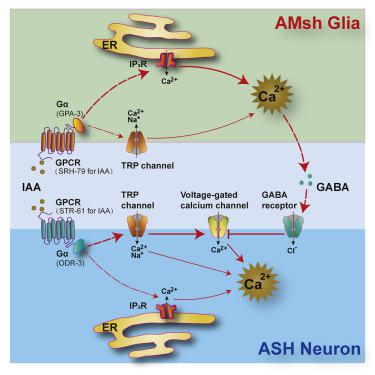Neuron ( IF 14.7 ) Pub Date : 2020-09-23 , DOI: 10.1016/j.neuron.2020.08.026 Duo Duan 1 , Hu Zhang 2 , Xiaomin Yue 2 , Yuedan Fan 2 , Yadan Xue 3 , Jiajie Shao 3 , Gang Ding 3 , Du Chen 3 , Shitian Li 3 , Hankui Cheng 3 , Xiaoyan Zhang 3 , Wenjuan Zou 3 , Jia Liu 3 , Jian Zhao 3 , Linmei Wang 3 , Bingzhen Zhao 4 , Zhiping Wang 3 , Suhong Xu 5 , Quan Wen 4 , Jie Liu 6 , Shumin Duan 7 , Lijun Kang 2

|
Glia are typically considered as supporting cells for neural development and synaptic transmission. Here, we report an active role of a glia in olfactory transduction. As a polymodal sensory neuron in C. elegans, the ASH neuron is previously known to detect multiple aversive odorants. We reveal that the AMsh glia, a sheath for multiple sensory neurons including ASH, cell-autonomously respond to aversive odorants via G-protein-coupled receptors (GPCRs) distinct from those in ASH. Upon activation, the AMsh glia suppress aversive odorant-triggered avoidance and promote olfactory adaptation by inhibiting the ASH neuron via GABA signaling. Thus, we propose a novel two-receptor model where the glia and sensory neuron jointly mediate adaptive olfaction. Our study reveals a non-canonical function of glial cells in olfactory transduction, which may provide new insights into the glia-like supporting cells in mammalian sensory procession.
中文翻译:

感觉神经胶质细胞检测排斥性气味并促进嗅觉适应。
胶质细胞通常被认为是神经发育和突触传递的支持细胞。在这里,我们报告神经胶质细胞在嗅觉传导中的积极作用。作为秀丽隐杆线虫的多峰感觉神经元,以前已知ASH神经元可检测多种厌恶气味。我们揭示了AMsh胶质细胞,包括ASH在内的多个感觉神经元的鞘细胞,通过与ASH中的受体不同的G蛋白偶联受体(GPCR)自主响应厌恶性气味。激活后,AMsh胶质细胞通过GABA信号传导抑制ASH神经元,从而抑制了厌恶性气味触发的回避并促进了嗅觉适应。因此,我们提出了一种新的两受体模型,其中胶质细胞和感觉神经元共同介导了适应性嗅觉。我们的研究揭示了神经胶质细胞在嗅觉转导中的非典型功能,这可能为哺乳动物感觉过程中的神经胶质样支持细胞提供新的见解。









































 京公网安备 11010802027423号
京公网安备 11010802027423号